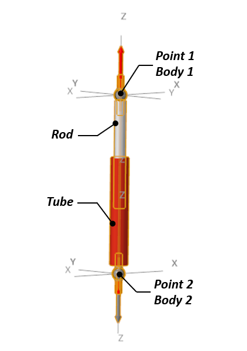Shock Absorber
The Shock Absorber is a damper entity designed to dissipate the energy stored in the suspension springs and damp the chassis motion.
The Shock Absorber force can be linear or non-linear reading the force versus velocity data from a table stored in a TeimOrbit format property file.
Parameters
- Damper Type
- The Shock Absorber can be a linear or non-linear type. When linear is selected, it enables the Damping Constant option and when non-linear is selected, it enables the Property File option.
- Damping Constant
- Damping constant value used when Shock Absorber is a linear type.
- Property File
- Shock Absorber properties stored in a TeimOrbit format property file containing a table of the force versus velocity.
- Use Rebound Stop
- Includes a Rebound Stop entity to limit the Shock Absorber component in rebound. The rebound stop is connected to the same bodies and points defined in the Shock Absorber. For more information, refer to the Rebound Stop documentation.
- Use Bump Stop
- Includes a Bump Stop entity to limit Shock Absorber component in jounce. The bump stop is connected to the same bodies and points defined in the Shock Absorber. For more information, refer to the Bump Stop documentation.
- Scale
- The scale options enable the scaling of the force and spring height without the need to directly modify the property file.
- Graphics
- Two cylinder graphics represent the Shock Absorber rod and tube in MotionView. This parameter allows you to modify the Rod and Tube radius for the visualization purposes.
Connecting a Shock Absorber
Property File for Shock Absorber
The Shock Absorber properties are stored in a TeimOrbit format property file. When the model is submitted to the solver, MotionSolve reads the property file for use during the simulation. If the units specified in property file differ from the model units, the solver converts the air spring properties to model units, however it leaves the property file unchanged.
The Shock Absorber property file contains header, units, and curve blocks. The units block specifies the length, mass, force, time, and angle units employed in the file. The curve block holds a table of velocity against force values for the damping force component, the data should be in ascending order.
$----------------------------------------------------------- HEADER
[HEADER]
FILE_TYPE = 'dpr'
FILE_VERSION = 4.0
FILE_FORMAT = 'ASCII'
$---------------------------------------------------------------------UNITS
[UNITS]
LENGTH = 'mm'
ANGLE = 'degrees'
FORCE = 'newton'
MASS = 'kg'
TIME = 'second'
$---------------------------------------------------------------------CURVE
[CURVE]
{ vel force}
-4916.935 -8.889
-1000.0 -3.0
-500.0 -1.5
-250.0 -0.75
-100.0 -0.3
0.0 0.0
100.0 0.3
250.0 0.75
500.0 1.5
1000.0 3.0
4914.298 9.0416
Outputs
The Shock Absorber outputs channels in the MotionSolve .plt and .abf files are summarized in the table below.
| Type | Component | Quantity |
|---|---|---|
| User Defined (.plt) REQSUB (.abf) |
ShockAbsorber - Damper Output | Length |
| Rate of change of length | ||
| Damper force | ||
| Direction Cosine - X | ||
| Direction Cosine - Y | ||
| Direction Cosine - Z |
